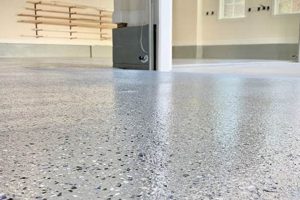Constructing a percussion instrument set independently involves sourcing individual components and assembling them into a cohesive unit for rhythmic expression. This process necessitates selecting shells, hardware, and cymbals based on desired tonal qualities and aesthetic preferences. For example, an individual might procure unfinished birch shells, purchase hoops and lugs separately, and then assemble and finish the drums themselves, rather than purchasing a pre-assembled kit.
The significance of this approach lies in the potential for customization and cost-effectiveness. It allows for the creation of a bespoke instrument tailored to specific musical needs and ergonomic considerations. Historically, this method provided an accessible entry point for musicians with limited resources, fostering innovation and experimentation in instrument design. The result is often an instrument more attuned to the player’s individual style.
The following sections will delve into the various aspects of this undertaking, including selecting suitable materials, understanding the essential hardware, and mastering the techniques for achieving optimal sound and playability.
Essential Considerations for Assembling a Percussion Instrument Set Independently
The following recommendations are designed to facilitate the creation of a functional and sonically pleasing instrument set through individual sourcing and construction. Adherence to these principles can mitigate common pitfalls and ensure a successful outcome.
Tip 1: Shell Selection Criteria: The type of wood significantly impacts tonal characteristics. Maple shells typically offer a balanced sound, while birch tends to be brighter and more resonant. Consider the desired musical genre and overall sonic profile when making this determination.
Tip 2: Hardware Compatibility Verification: Ensure all hardware components, such as lugs, hoops, and mounting brackets, are compatible with the selected shells. Mismatched components can lead to instability and potential damage. Precise measurements are critical.
Tip 3: Head Selection and Tuning: Drumhead selection is pivotal in shaping the instrument’s sound. Experiment with different head types (e.g., coated, clear, single-ply, double-ply) to achieve the desired attack, sustain, and overall tone. Proper tuning is essential for optimal resonance and pitch.
Tip 4: Bearing Edge Preparation: The bearing edge is the point of contact between the drumhead and the shell. Ensure the bearing edges are smooth, even, and properly angled. Imperfections in the bearing edge can negatively impact tuning stability and sound quality.
Tip 5: Cymbal Selection and Placement: Cymbal selection should complement the overall kit’s sonic characteristics. Consider factors such as weight, size, and alloy composition. Proper placement and angling of cymbals are crucial for achieving balanced sound projection and ergonomic playability.
Tip 6: Consistent Lug Tension: During assembly, maintain consistent tension across all lugs to ensure even head seating and optimal resonance. A drum dial or similar tuning aid can assist in achieving precise and balanced tension.
Tip 7: Hardware Mounting and Stability: Securely mount all hardware to prevent unwanted vibrations or movement during play. Use appropriate tools and techniques to ensure that all connections are tight and stable. Consider using isolation mounts to reduce unwanted resonance.
By paying close attention to these recommendations, individuals can craft an instrument set that reflects their personal preferences and meets their specific musical requirements. The result is an instrument that is both functional and aesthetically pleasing.
The ensuing discussion will address advanced techniques and considerations for fine-tuning and optimizing the independently constructed percussion instrument set.
1. Shell Material Selection
Shell material selection is a critical determinant of the sonic characteristics and overall quality of a percussion instrument set constructed independently. The choice of material directly influences the drum’s resonance, tonal color, and projection capabilities, thus requiring careful consideration within the context of independent percussion instrument construction.
- Wood Species: Resonance and Tonality
Different wood species possess unique resonant properties, directly impacting the drum’s tone. Maple, known for its balanced frequencies, is a versatile choice suitable for various musical genres. Birch provides a brighter, more articulate sound, often favored in recording situations. Mahogany offers warmer, darker tones. The selection of wood species, therefore, defines the instrument’s fundamental sonic signature. For example, a kit intended for jazz might benefit from maple or mahogany, while a kit designed for rock music could utilize birch or maple.
- Shell Ply and Thickness: Durability and Projection
The number of plies and the overall thickness of the shell influence both its durability and its projection capabilities. Thicker shells generally provide greater projection and durability but may sacrifice some resonance. Thinner shells offer enhanced resonance and sensitivity but may be more prone to damage. This consideration is particularly relevant in an independent construction context, as it dictates the instrument’s resilience to wear and tear, especially if subjected to frequent transport and performance. The thickness of shell has direct correlation between sound produced.
- Hybrid Shell Construction: Blending Tonal Characteristics
Hybrid shell construction, involving the combination of different wood species in a single shell, allows for a tailored blend of tonal characteristics. A shell might feature an inner ply of mahogany for warmth and an outer ply of birch for articulation. This approach enables individuals to fine-tune the drum’s sound to meet specific requirements. Hybrid shells exemplify the level of customization achievable through independent construction.
- Shell Finish: Aesthetic and Acoustic Considerations
While primarily aesthetic, the shell finish can also impact the drum’s acoustic properties. Thicker, more heavily applied finishes can dampen resonance, while thinner, natural finishes allow for greater shell vibration. In independent construction, the choice of finish offers an opportunity to balance aesthetic preferences with the desired sonic outcome. A natural oil finish, for example, preserves the shell’s natural resonance, whereas a thick lacquer finish might slightly reduce it.
These facets of shell material selection directly influence the sonic characteristics and durability of a percussion instrument set. Careful evaluation of these factors allows for the creation of a bespoke instrument that meets specific sonic and performance requirements. The opportunity to precisely control these parameters underscores a key benefit of independent percussion instrument set construction, empowering the individual to tailor the instrument to their specif
ic needs and preferences.
2. Hardware Compatibility
Hardware compatibility represents a foundational element in percussion instrument construction. Independent assembly necessitates meticulous attention to the dimensional and functional relationships between shell components, mounting systems, and tensioning mechanisms. A failure to ensure compatibility at this stage invariably results in structural instability, compromised sound quality, or complete assembly failure. For instance, utilizing lug casings designed for thinner shells on thicker shells introduces excessive stress, potentially leading to shell cracking or hardware failure under tension. Such incompatibility directly negates the cost-effectiveness and customization benefits typically sought in independent construction projects.
The selection of compatible hardware extends beyond the shell. Cymbal stands, tom mounts, and bass drum spurs must integrate seamlessly with the overall kit configuration. An ill-fitting tom mount, for example, can restrict resonance and sustain. In cymbal stands, stability and adjustability are paramount, and incompatible threading or base diameters will cause problems. A practical application of this understanding involves meticulous measurement of shell thicknesses and hardware specifications before procurement. Reputable suppliers often provide detailed technical drawings to aid in this process. A thorough understanding of thread types (e.g., metric vs. imperial) is also crucial, as mismatched threads can damage both hardware and shells.
In summary, hardware compatibility is not merely a peripheral consideration but rather a central prerequisite for successful percussion instrument construction. Addressing this aspect requires a proactive approach involving precise measurement, thorough research, and a commitment to using components designed to function harmoniously. The absence of such diligence undermines the entire project, potentially rendering the instrument unusable or sonically inferior. The investment in compatible hardware and the knowledge to ensure its proper integration ultimately determines the longevity and performance of the independently constructed percussion instrument set.
3. Head type
The selection of drumheads exerts a significant influence on the sonic characteristics of a percussion instrument set. In the context of independent percussion instrument construction, the choice of head type presents a critical opportunity to tailor the instrument’s sound to specific performance requirements. The following sections detail the key considerations for head selection in this context.
- Single-Ply Heads: Resonance and Sensitivity
Single-ply drumheads, composed of a single layer of material, offer enhanced resonance and sensitivity. These heads are typically preferred for applications where a nuanced response and a wide dynamic range are desired. In a percussion instrument set created independently, single-ply heads can enhance the instrument’s ability to capture subtle performance nuances, making them suitable for genres such as jazz or light acoustic music.
- Double-Ply Heads: Durability and Attack
Double-ply drumheads, constructed from two layers of material, provide increased durability and a more focused attack. These heads are well-suited for high-volume applications and offer greater resistance to wear and tear. For percussion instrument sets built independently for rock, metal, or other high-energy genres, double-ply heads provide the necessary robustness and sonic projection.
- Coated vs. Clear Heads: Tonal Coloration
The presence or absence of a coating on a drumhead influences its tonal coloration. Coated heads tend to produce a warmer, more controlled sound, while clear heads offer a brighter, more resonant tone. Independent builders can leverage this distinction to shape the instrument’s overall sonic profile. For example, coated heads on snare drums can reduce unwanted overtones, while clear heads on tom-toms can enhance their sustain.
- Specialty Heads: Specific Sonic Effects
A variety of specialty drumheads are available, designed to produce specific sonic effects. These include heads with integrated dampening rings, textured surfaces, or unique material compositions. In independent percussion instrument construction, specialty heads offer the opportunity to experiment with unconventional sounds and create distinctive sonic textures. Examples include heads designed to emulate vintage drum sounds or those optimized for electronic drum triggering.
The choice of head type is a crucial aspect of independent percussion instrument set construction, directly influencing the instrument’s sonic capabilities and performance characteristics. By carefully considering the factors outlined above, individuals can create instruments that meet their specific sonic and performance needs, further highlighting the benefits of custom construction.
4. Bearing edge quality
The bearing edge, the point of contact between a drum shell and its head, significantly influences a percussion instrument’s resonance, sustain, and tuning stability. In the realm of independent percussion instrument construction, the precision and quality of the bearing edge are paramount. Imperfections in this area directly translate to compromised tonal characteristics and potential performance issues.
- Contact Area and Resonance
The amount of contact area between the bearing edge and the drumhead directly affects resonance. A sharp, well-defined edge allows the head to vibrate freely, maximizing sustain and tonal clarity. Conversely, a rounded or uneven edge dampens vibration, resulting in a duller sound with reduced sustain. The “drum kit diy” builder must strive for consistent contact around the entire circumference of the drum.
- Angle and Tonality
The angle of the bearing edge impacts the drum’s tonality. Sharper angles typically produce brighter, more articulate tones, while more rounded angles yield warmer, darker sounds. Different bearing edge angles can be combined within a single kit to achieve a diverse range of tonal colors. An individual constructing a percussion instrument set independently can experiment with varying angles to tailor the sound to specific musical requirements.
- Surface Smoothness and Tuning Stability
A smooth, consistent bearing edge surface is essential for tuning stability. Imperfections, such as bumps or dips, prevent the drumhead from seating properly, leading to difficulty in achieving and maintaining a consistent pitch. The independent builder must meticulously sand and finish the bearing edge to ensure a smooth and even surface.
- Concentricity and Head Seating
The bearing edge must be perfectly concentric to ensure even head seating. An out-of-round bearing edge will cause the head to vibrate unevenly, resulting in unwanted overtones and difficulty in achieving a clear, fundamental pitch. Careful attention to concentricity is a hallmark of quality craftsmanship in independent drum construction. Improperly cut bearing edges wi
ll result in an instrument of limited musical value.
The quality of the bearing edge is not merely an aesthetic detail but a functional imperative. Careful attention to contact area, angle, surface smoothness, and concentricity is essential for achieving optimal sound quality and tuning stability in independently constructed percussion instruments. The time and effort invested in creating precise bearing edges directly translates to an instrument with superior tonal characteristics and overall performance capabilities.
5. Cymbal Characteristics
In the context of independent percussion instrument construction, cymbal selection transcends mere acquisition; it represents a critical element in defining the kit’s overall sonic identity and expressive capabilities. The deliberate selection of cymbals is vital to achieving a balanced and tonally cohesive instrument.
- Alloy Composition: Timbral Foundation
Cymbal alloy, primarily bronze, dictates fundamental timbral qualities. B20 bronze (80% copper, 20% tin) offers complex overtones and sustain, suitable for diverse musical applications. B8 bronze (92% copper, 8% tin) provides a brighter, more focused sound. The choice of alloy establishes a foundational sonic characteristic that influences the kit’s overall tonal palette. For instance, a builder might choose B20 cymbals for warmer, more traditional tones and B8 cymbals for sharper, more aggressive sounds.
- Weight and Thickness: Responsiveness and Volume
Cymbal weight and thickness directly impact responsiveness and volume. Lighter, thinner cymbals respond quickly to subtle strokes, producing lower volumes and shorter sustain, ideal for nuanced playing. Heavier, thicker cymbals generate greater volume and longer sustain, suited for louder genres. When undertaking “drum kit diy,” matching cymbal weight to the kit’s intended use will ensure proper dynamics.
- Size and Profile: Pitch and Overtones
Cymbal size and profile influence pitch and the complexity of overtones. Larger cymbals generally produce lower pitches and longer sustain, while smaller cymbals offer higher pitches and shorter sustain. The profile, or curvature, of the cymbal affects the blend of overtones. Flatter profiles tend to be brighter and more cutting, while more curved profiles produce richer, more complex sounds. A builder could pair a larger, flatter ride cymbal with smaller, curved crash cymbals to achieve a balanced range of frequencies.
- Lathing and Hammering: Complexity and Character
Lathing (grooves on the cymbal surface) and hammering (indentations created by a hammer) contribute to the complexity and character of the cymbal’s sound. Lathing affects sustain and brightness, while hammering adds tonal complexity and warmth. Extensive hammering can create darker, more complex tones, while minimal hammering results in brighter, more focused sounds. A “drum kit diy” approach allows for the careful selection of cymbals with specific lathing and hammering patterns to achieve a personalized sound.
Integrating these cymbal characteristics within the framework of independent percussion instrument construction permits a highly personalized sonic signature. By attending to alloy composition, weight, size, and manufacturing techniques, the builder can curate a cymbal set that complements the kit’s overall tonal qualities and meets specific musical needs, resulting in a cohesive and expressive instrument.
6. Lug tension consistency
Lug tension consistency is a critical factor in the successful execution of a “drum kit diy” project, directly impacting the instrument’s tonal clarity, sustain, and overall playability. Inconsistent tension across the lugs surrounding a drumhead creates uneven stress, resulting in a compromised sound. This manifests as unwanted overtones, difficulty in achieving a stable and accurate pitch, and a reduction in the instrument’s resonant qualities. For example, if one lug is significantly tighter than others, the drumhead will be stretched unevenly, producing a “dead” sound and making accurate tuning nearly impossible. This directly undermines the benefits sought by undertaking a “drum kit diy” project namely, customization and cost-effectiveness. The effort invested in selecting quality shells, hardware, and heads is negated by a failure to properly tension the drumhead.
Achieving consistent lug tension requires a systematic approach. The common star pattern tuning method, where lugs are tightened in opposing pairs, helps distribute tension evenly across the drumhead. A drum dial or electronic tuner can provide precise measurements of tension at each lug, allowing for fine adjustments to achieve uniform pressure. The practical application of this understanding involves taking frequent measurements during the tuning process and making small, incremental adjustments rather than large, abrupt ones. This prevents over-tensioning individual lugs and minimizes the risk of damaging the drumhead or shell. Experienced “drum kit diy” practitioners often develop a tactile sense for tension, using the pitch produced when tapping near each lug as a guide, supplementing measurements with auditory feedback.
In summary, lug tension consistency is not merely a minor detail but rather an essential element of a successful “drum kit diy” endeavor. The challenges associated with achieving consistent tension can be overcome through the application of systematic tuning techniques, the use of measuring tools, and the development of an experienced ear. Attention to this critical detail ensures that the independently constructed drum kit achieves its full sonic potential, realizing the benefits of customization and optimized performance that are central to the “drum kit diy” philosophy. The investment of time and effort in mastering this skill is essential for any individual pursuing percussion instrument construction.
Frequently Asked Questions
The following addresses common inquiries and misconceptions regarding the independent construction of percussion instrument sets, often referred to by the keyword phrase used in the originating article.
Question 1: What is the typical cost associated with independently constructing a percussion instrument set compared to purchasing a pre-assembled kit?
Cost varies considerably based on the quality of materials chosen. While savings are possible, achieving professional-grade sound often necessitates investment in quality shells, hardware, and cymbals, potentially equaling or exceeding the cost of a mid-range pre-assembled kit. Significant savings are achievable primarily when utilizing salvaged or repurposed materials.
Question 2: What specialized tools are required for a percussion instrument set build?
Essential tools include a drill press, sander, measuring instruments (calipers, rulers), woodworking clamps, and various hand tools (screwdrivers, wrenches). Precision instruments are necessary for accurate drilling, cutting and assembly. A spray booth may also be necessary for applying finish.
Question 3: What are the most common mistakes encountered during independent drum construction, and how can they be avoided?
Common errors include imprecise drilling, inadequate shell preparation, and incompatible hardware selection. Meticulou
s measurement, proper shell sanding and sealing, and thorough research into hardware specifications are crucial to prevent these issues.
Question 4: How does the choice of shell material impact the overall sound of the finished drum kit?
Shell material significantly influences resonance and tone. Maple offers balanced frequencies, birch produces brighter tones, and mahogany provides warmer characteristics. The selection should align with the intended musical genre and desired sonic profile.
Question 5: What are the key considerations for ensuring proper tuning stability in a independently constructed percussion instrument set?
Consistent lug tension is paramount. Employ a drum dial or electronic tuner to ensure uniform tension around the drumhead. Properly prepared bearing edges are also essential for optimal head seating and tuning stability.
Question 6: How does hardware selection and mounting influence resonance and sustain?
Heavy, mass-produced hardware may dampen shell vibration. Lightweight, high-quality hardware can enhance resonance. Isolation mounting systems further reduce unwanted vibration transfer, maximizing sustain.
Successfully building a custom percussion instrument set depends on both the precision of the work and the compatibility of all parts, each impacting the final sound.
The next section explores troubleshooting common issues encountered during the independent construction of percussion instrument sets.
Conclusion
The preceding discussion elucidated the multifaceted nature of independent percussion instrument construction, often referred to as “drum kit diy.” From the critical selection of shell materials and compatible hardware to the nuanced considerations of head type, bearing edge quality, cymbal characteristics, and lug tension consistency, each element contributes significantly to the instrument’s final sonic output and overall playability. Mastering these fundamentals is essential for those seeking to craft a bespoke instrument tailored to specific musical needs.
The pursuit of “drum kit diy” demands meticulous attention to detail, a commitment to quality craftsmanship, and a thorough understanding of acoustic principles. While challenges may arise, the rewards of creating a personalized instrument uniquely suited to individual artistic expression are substantial. Continued exploration and refinement of these techniques will undoubtedly foster innovation and advancement within the realm of percussion instrument design and construction.







